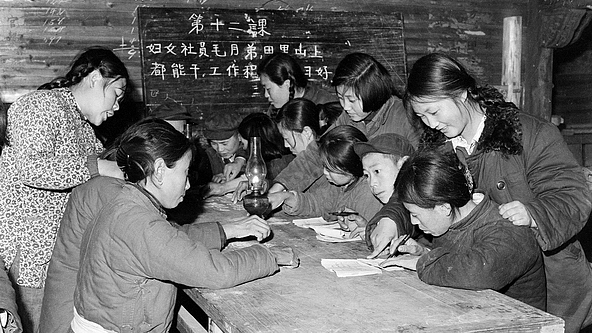
As the world's second largest economy, China accounted for 18.2 percent of global GDP in 2017, data from the Academic Center for Chinese Economic Practice and Thinking (ACCEPT) show. Scholars from ACCEPT published the paper on Sunday, looking back on national and global economic twists and turns a week ahead of the 70th anniversary of New China's establishment.
Economic development in the first 30 years
ACCEPT data show that China's average GDP growth rate from 1949 to 1978 was 6.68 percent. During that time, China successfully established a public health policy focusing on disease prevention by providing free vaccines, as well as setting up a cooperative medical care system to provide basic medical services to villagers.
The public health policy resulted in a boom in the country's working population, providing ample labor resources for economic growth. China's literacy campaign brought down the illiteracy rate to 23 percent in 1982 from a high of 80 percent in 1949. Efforts to enhance the quality of China's labor force set up a sound basis for further development.

Night school in east China's Anhui province in 1958. /VCG File Photo
Night school in east China's Anhui province in 1958. /VCG File Photo
Infrastructure construction ranging from transportation to hydraulic and irrigation projects also saw success. By the end of 1978, the total length of transportation lines stood at more than 123 million kilometers, about six times longer than in 1949.
The period also saw setbacks. A lack of a proper incentive mechanism for governmental officials led to low efficiency in production, while abandoning the principle of profit maximization led to low and poor quality investment. According to ACCEPT, the excessive concentration of decision-making power resulted in disastrous outcomes.
These problems were addressed and dealt with in the following 40 years.
The reform and opening-up period
There were virtually no private companies in China in 1978. 40 years later in 2018, the transformation of the reform and opening-up era has seen private companies contribute more than half of the national tax revenue, make up more than 60 percent of GDP and provide 80 percent of employment opportunities.
Private sector growth has been built on strong incentives granted to regional authorities to help the entry of enterprises, with local governments allowed to keep and manage a significant chunk of tax revenue. The result was the booming entry and development of China's burgeoning private sector.
The period also saw sweeping land reform, while policies encouraging financial deepening and proactive macro-economic adjustments took place.
Vladimir Popov, principal researcher at the Central Economics and Mathematics Institute of the Russian Academy of Sciences, told an ACCEPT seminar on Sunday that China's economic success since 1978 could be attributed to the foundations laid in the first 30 years of the country's development.

Vladimir Popov, principal researcher at the Central Economics and Mathematics Institute of the Russian Academy of Sciences, speaks at an ACCEPT seminar on September 22, 2019. / ACCEPT Photo
Vladimir Popov, principal researcher at the Central Economics and Mathematics Institute of the Russian Academy of Sciences, speaks at an ACCEPT seminar on September 22, 2019. / ACCEPT Photo
In his view, the strong state institutions that China established to implement regulations, along with a relatively low crime rate, were major factors for economic liberalization succeeding in China, despite similar policies largely failing in countries and regions like the former Soviet Union, South America and Africa.
Challenges in the next 30 years
ACCEPT's report predicts that China will become the world's largest economy in terms of its share of GDP in the next 15 years, while possibly joining the ranks of high-income countries in the next five years.
The report also warned that the country will have to face challenges like cultivating new growth drivers as it transitions from high-speed development to high-quality development. In doing so, China needs to double its middle-income group from 400 million to 800 million in the next 15 years.
The to-do-list compiled by the report also includes further market-oriented reform of state-owned enterprises, and a need to participate in global economic governance with a practical mindset.